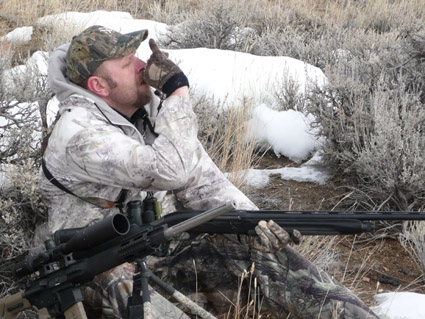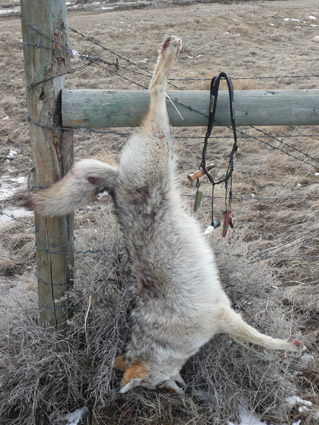 The author opening a stand with a coyote interrogation howl. |
We traveled several hours to reach our hunting area and were greeted by a blizzard. Rain was mixed with snow and the wind was howling. It was the first day of the Nevada State Coyote Calling Championships. Despite the inclement weather we called our guts out, but the coyotes had our number that day. As the first day of competition came to an end we’d only put three coyotes in the truck. Not nearly enough to win a major calling contest.
We picked ourselves up, brushed off and drove several hours south to another area. We spent all night locating coyotes. Final check-in was scheduled for 3 p.m. so we didn’t have much time. We were under the gun and decided to travel fast and light—back to the basics. We left the electronic callers in the truck hoping that less to carry would mean more stands. Stand after stand the coyote gods smiled upon us as they just kept coming. In 5 hours we killed 10 coyotes. Luck was on our side that day as we headed to check-in to claim our prize. It was an incredible half-day of calling. We didn’t use decoys or fancy electronic callers, just mouth blown calls and a little know-how.
Over the years I’ve tried just about everything on the market for predator hunting. I have a condition that forces me to buy every new call on the market, just to see if it’s better than the last. Through trial and error I’ve learned there is a time and place for both electronic and mouth-blown calls. I believe the complete predator hunter needs both, and needs to know how and when to use them.
Mouth-Blown Calls
For me there is no greater accomplishment than fooling a predator with a mouth-blown call. It’s like catching trout on a dry-fly. The ability to fool the wariest of predators using nothing more than a piece of plastic and a reed requires skill and practice. I can’t count the number of hours I spent learning distress sounds and coyote vocalizations, but my wife can tell you how painful it was for the rest of the family.
Mouth-blown calls are very inexpensive which makes it easy to get started. They come in all shapes and sizes and allow you to do everything from bird sounds to distress calls to coyote vocalizations. An electronic caller does offer some advantages, but you don’t need one to be a successful predator caller.
Mouth-blown calls are small, easy to carry, and they make it easier to sneak into your stand. You don’t risk any un-necessary exposure walking around setting up an electronic caller. If I think coyotes might spot me approaching a particular stand, I will use mouth-blown calls to remain as invisible as possible. You might be surprised how often this pays off.
Electronic Callers
 A beautiful Montana coyote hanging next to the authors lanyard of favorite mouth-blown calls. |
One advantage of an electronic caller is it produces the perfect sound every time. You can jump right into predator hunting and focus on other key elements such as scouting, setup, wind, and sun position. Many new predator hunters are too focused on sound alone and forget other vital elements for success.
Electronic callers offer a wide variety of sounds to create realistic scenarios. I frequently use crow and magpie sounds as they frequently travel with coyotes. More sounds to choose from means more ways to fool the coyote throughout the year. Don’t ever be afraid to try new or different distress sounds. Sometimes that’s all it takes to fool a call-shy coyote.
Other advantages include more volume for windy days and call placement. I like to position the e-caller away from where I’m sitting. This allows me to see predators approaching and prepare for a shot without being seen. This is definitely an advantage when calling alone.
Recommendations
1. When selecting a hand call, find the one that is easiest for you to use. There are several that make the same sounds. Some will fit you and others will not. You might have to try a few calls to see which one works best for you.
2. I personally prefer open-reed calls over closed-reed calls. A single open-reed call offers a variety of sounds including cottontail, jackrabbit, coyote vocalizations, and even bird distress. You will also find that open-reed calls don’t freeze in cold weather. If you’re going to use closed-reed calls, be sure to carry an extra in your pocket at all times.
3. Carry a mouth-blown call to every stand. Electronics can malfunction and batteries can go bad at any time. Nothing is worse than hiking to a stand to find your e-caller is not working. A mouth-blown call just might save the day.
4. Your wife might be more willing to let you buy an expensive electronic caller if she knows of the anguish the family will go through as you experiment with mouth-blown calls. I’m sure my wife will gladly be a reference.
About The Author
Dustin has been calling predators for nearly 20 years. He has competed in coyote calling contests around the Western U.S. for more than a dozen years and has consistently excelled including many wins and top finishes. He enjoys sharing his knowledge of predator hunting with others through calling seminars and magazine articles. To learn more about Dustin or the equipment he uses visit www.predatordown.com.






